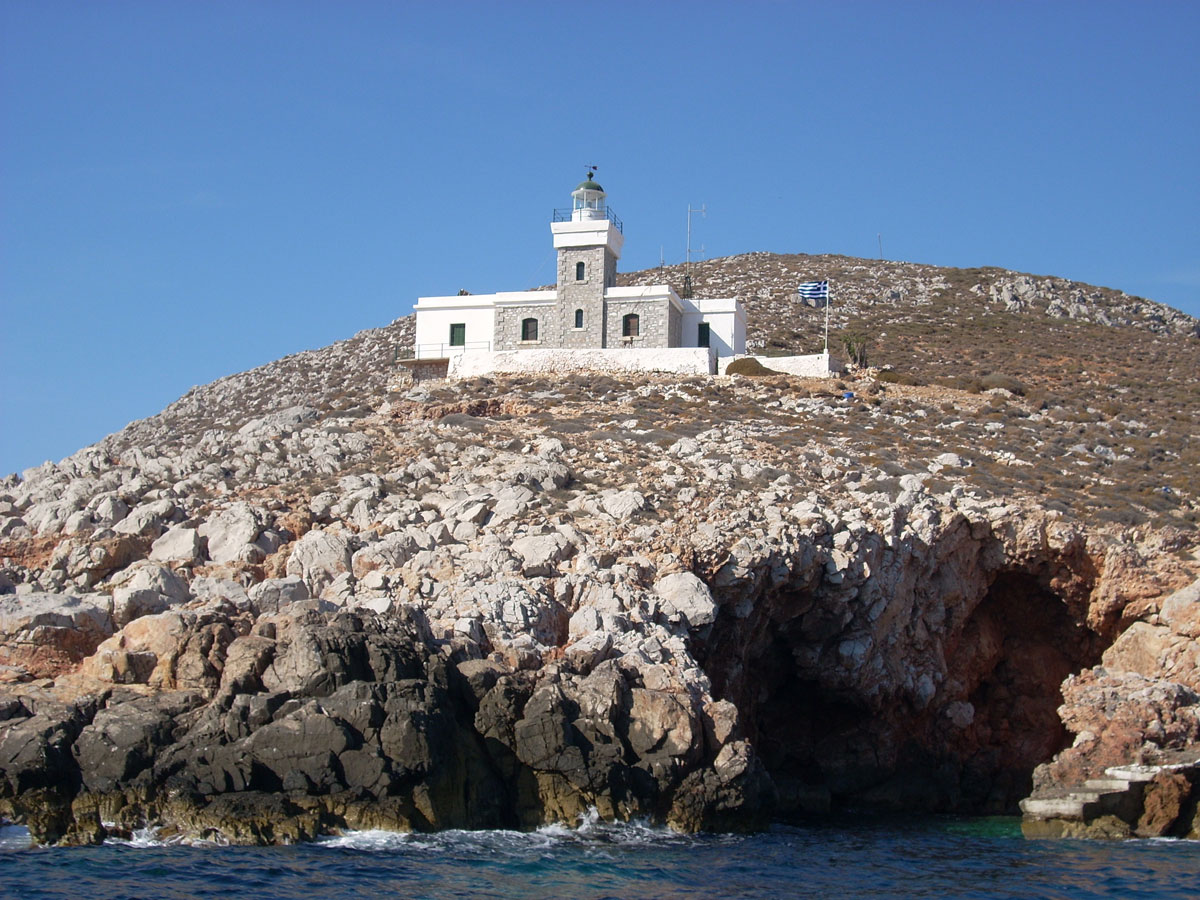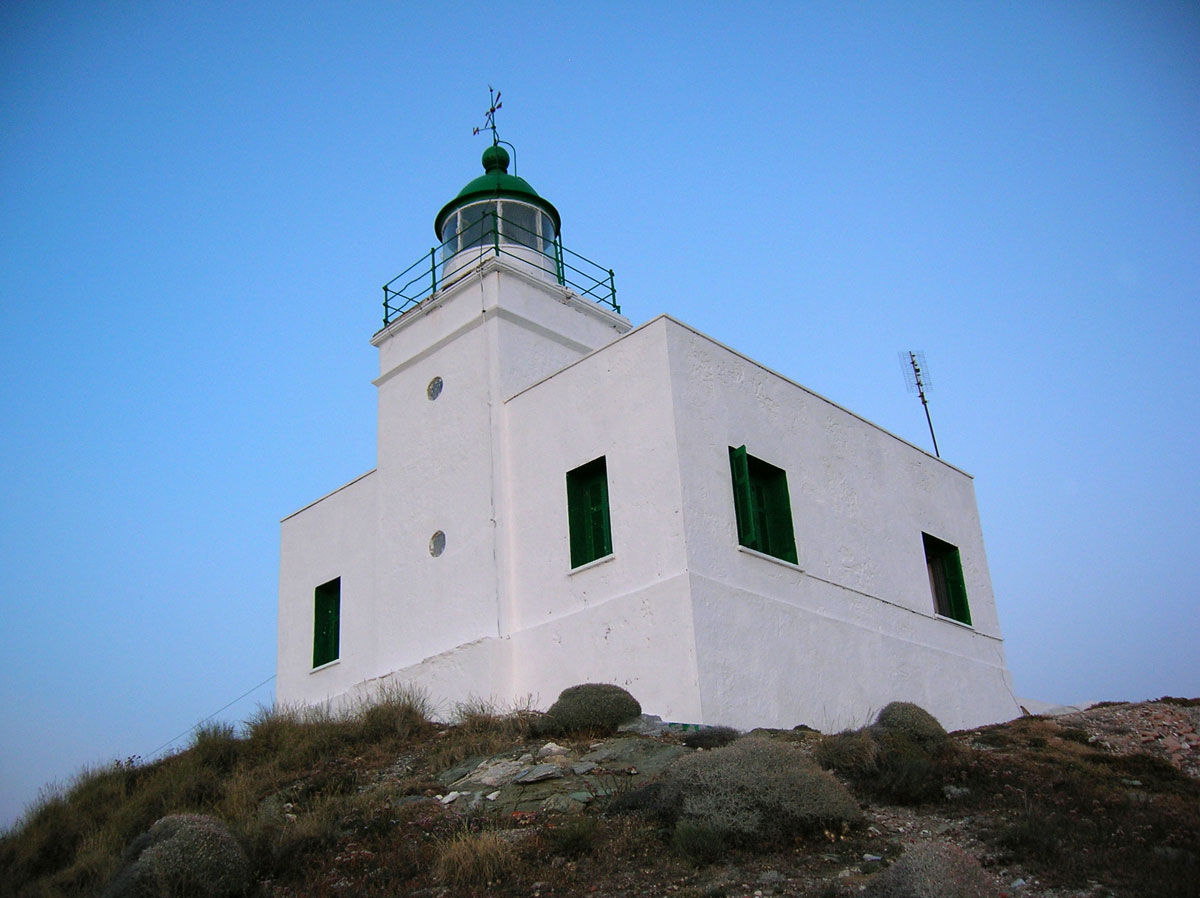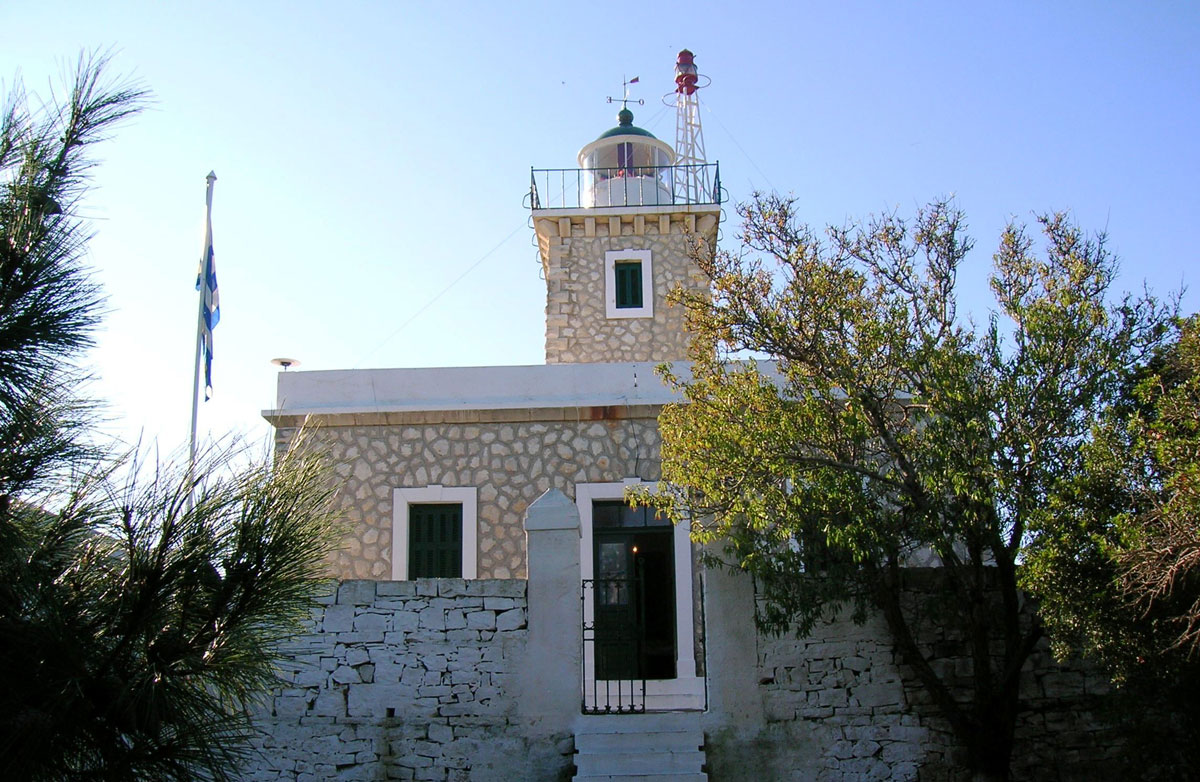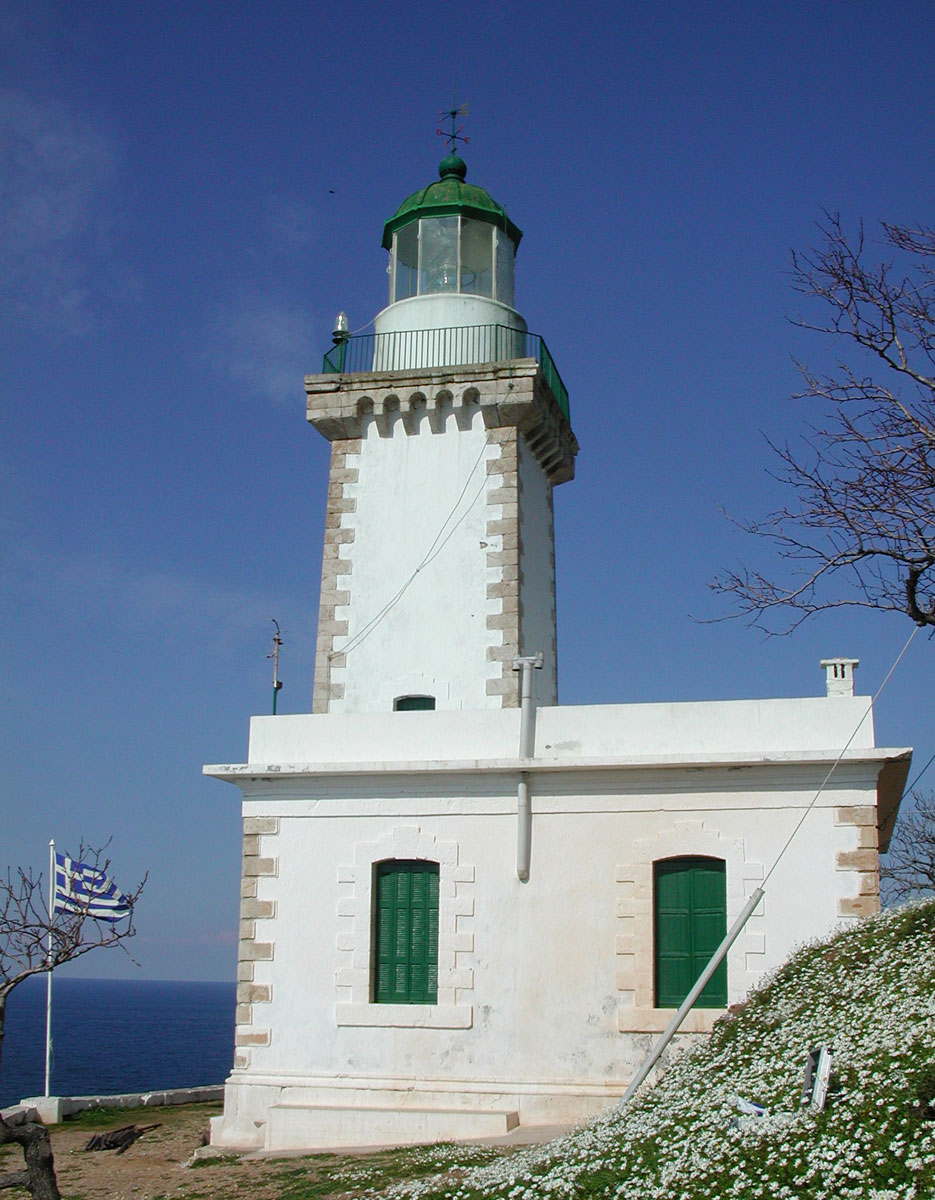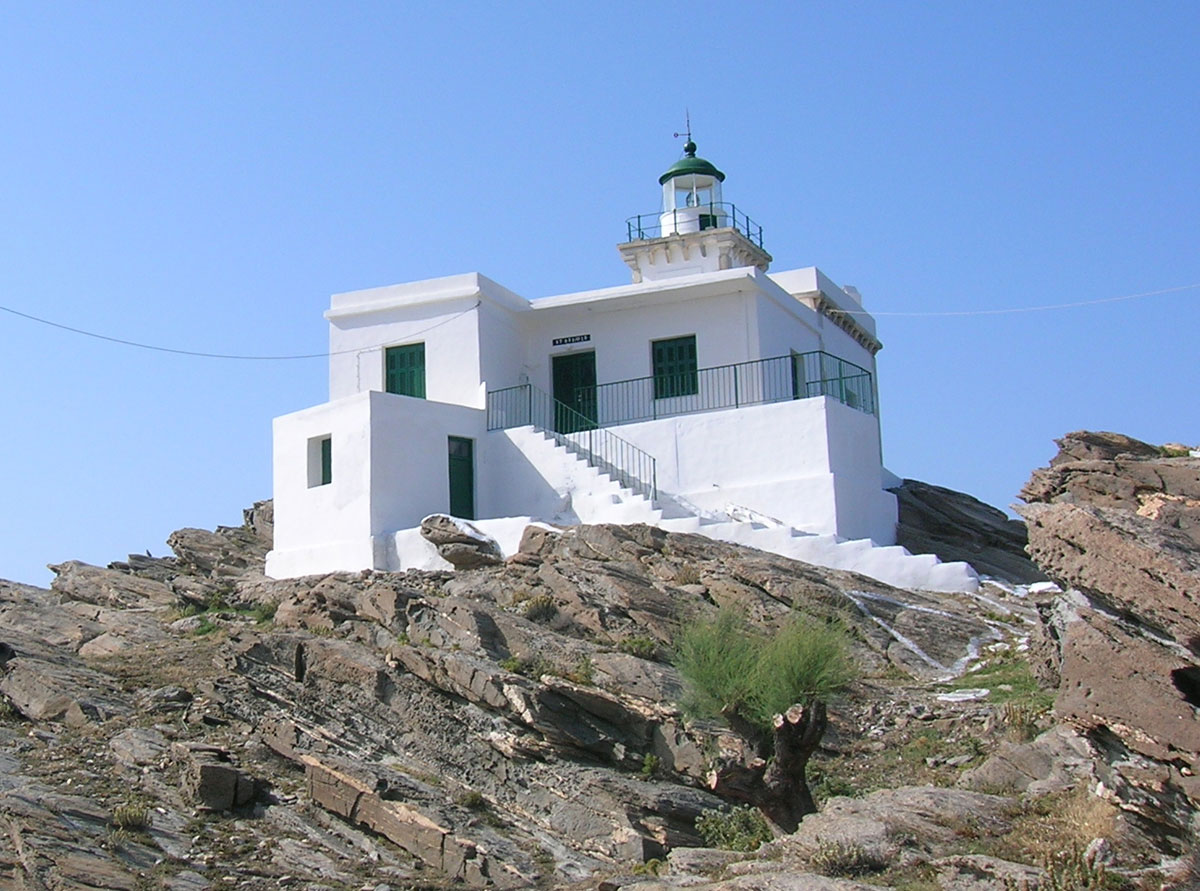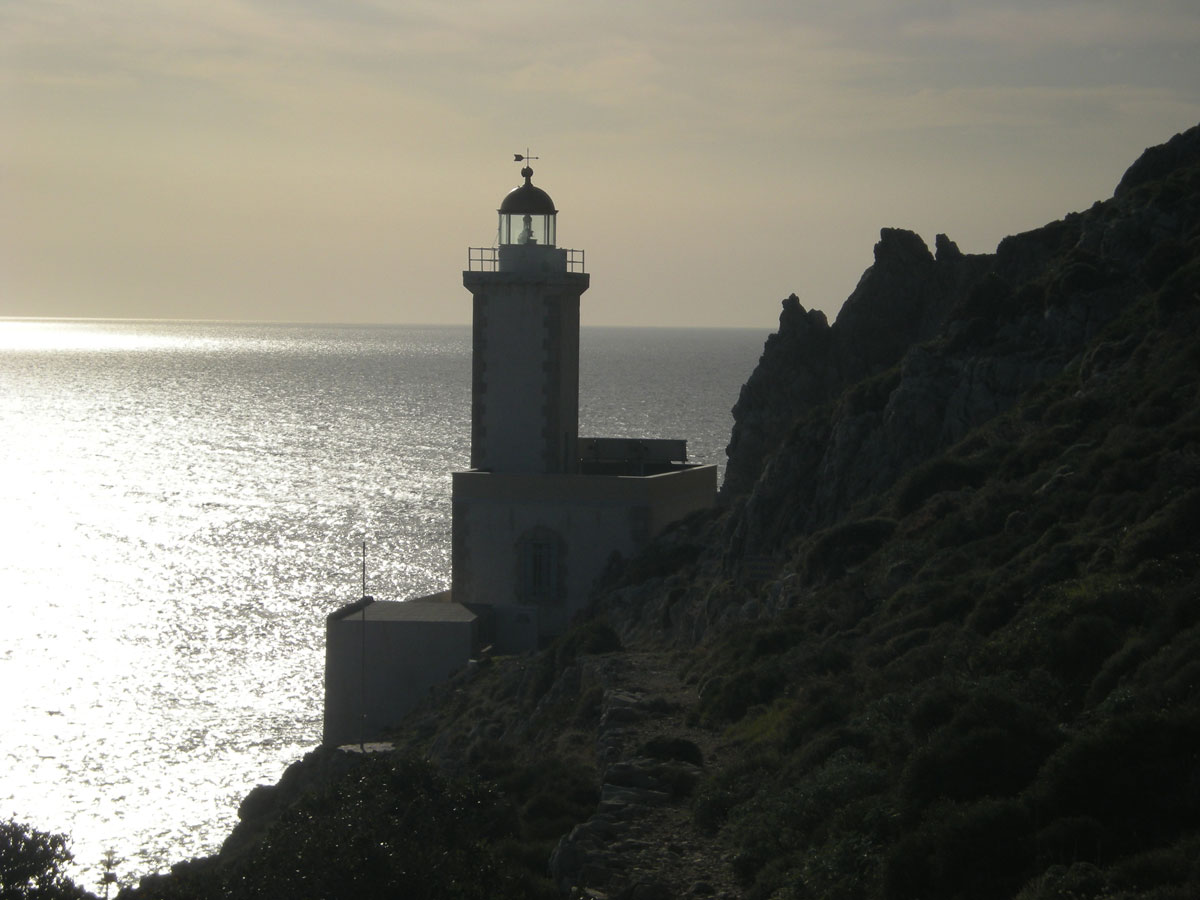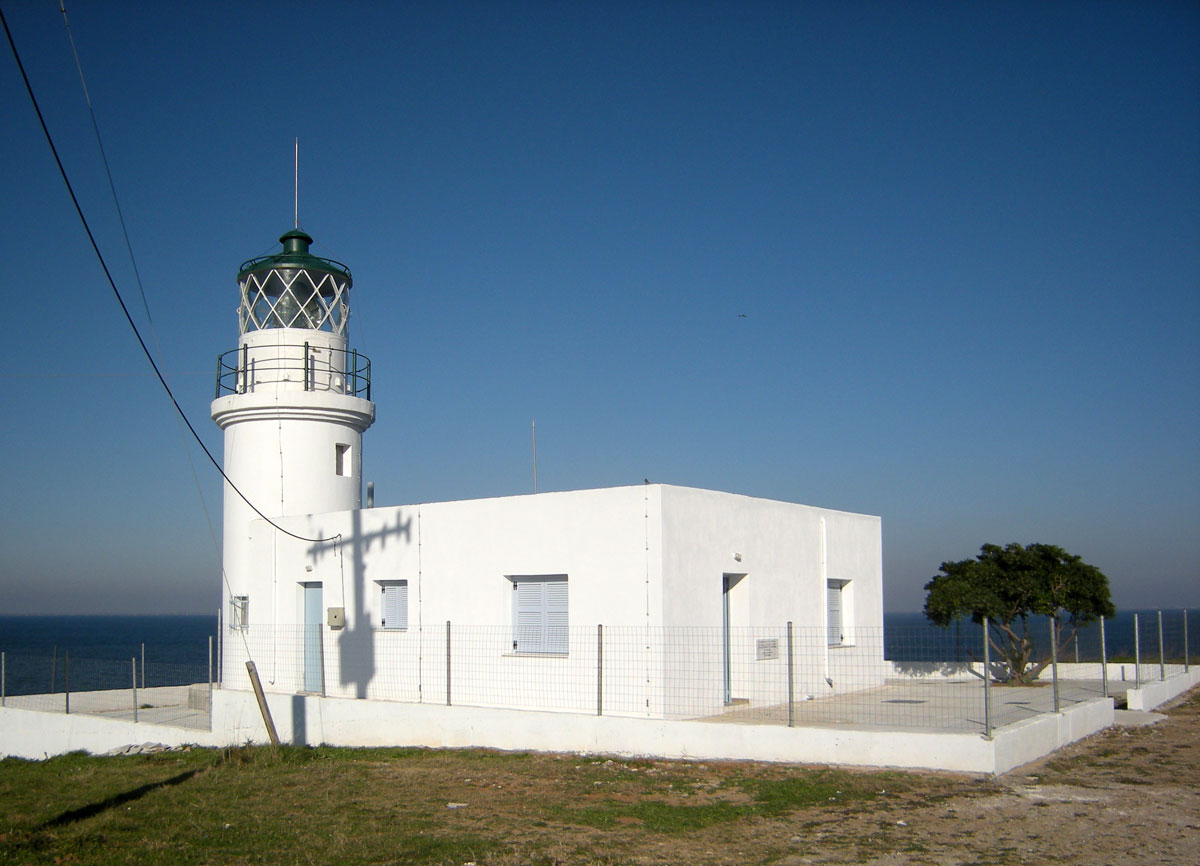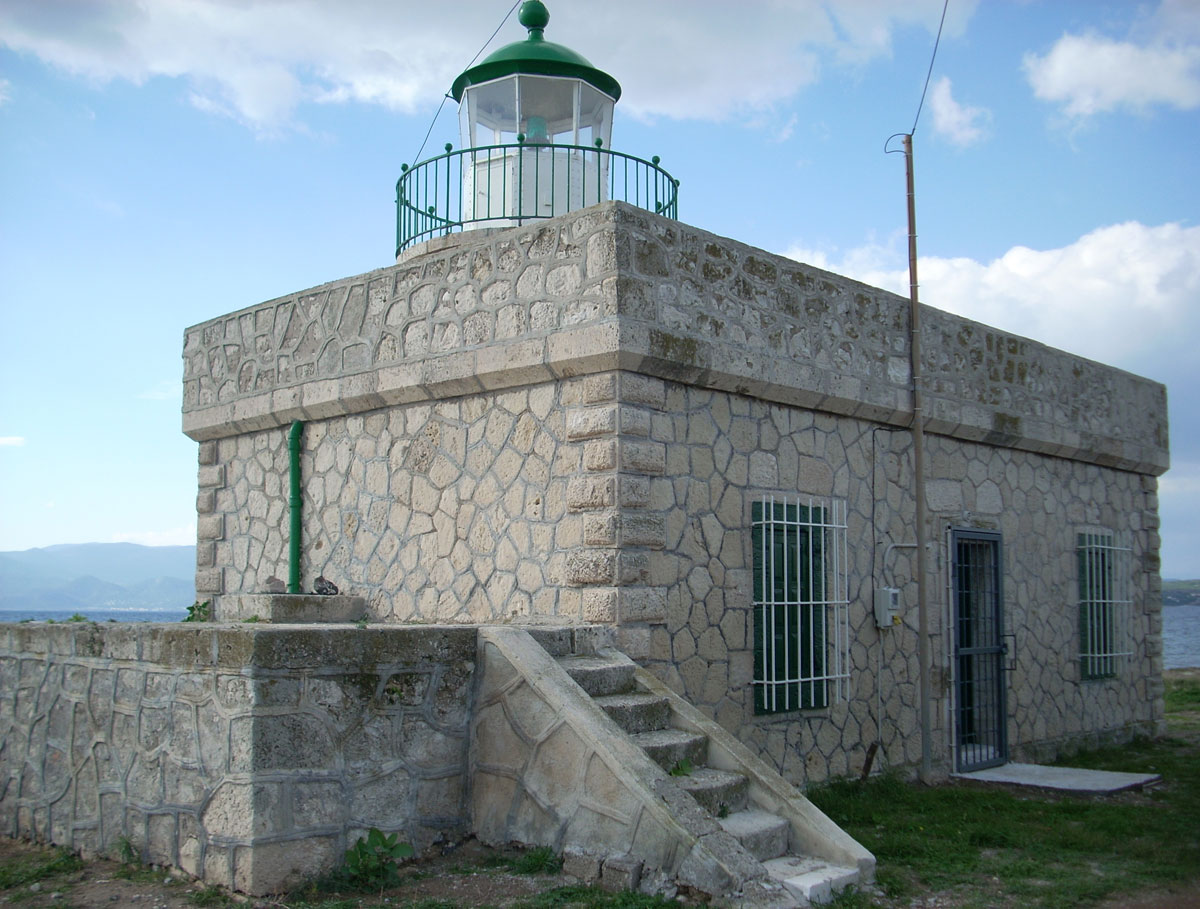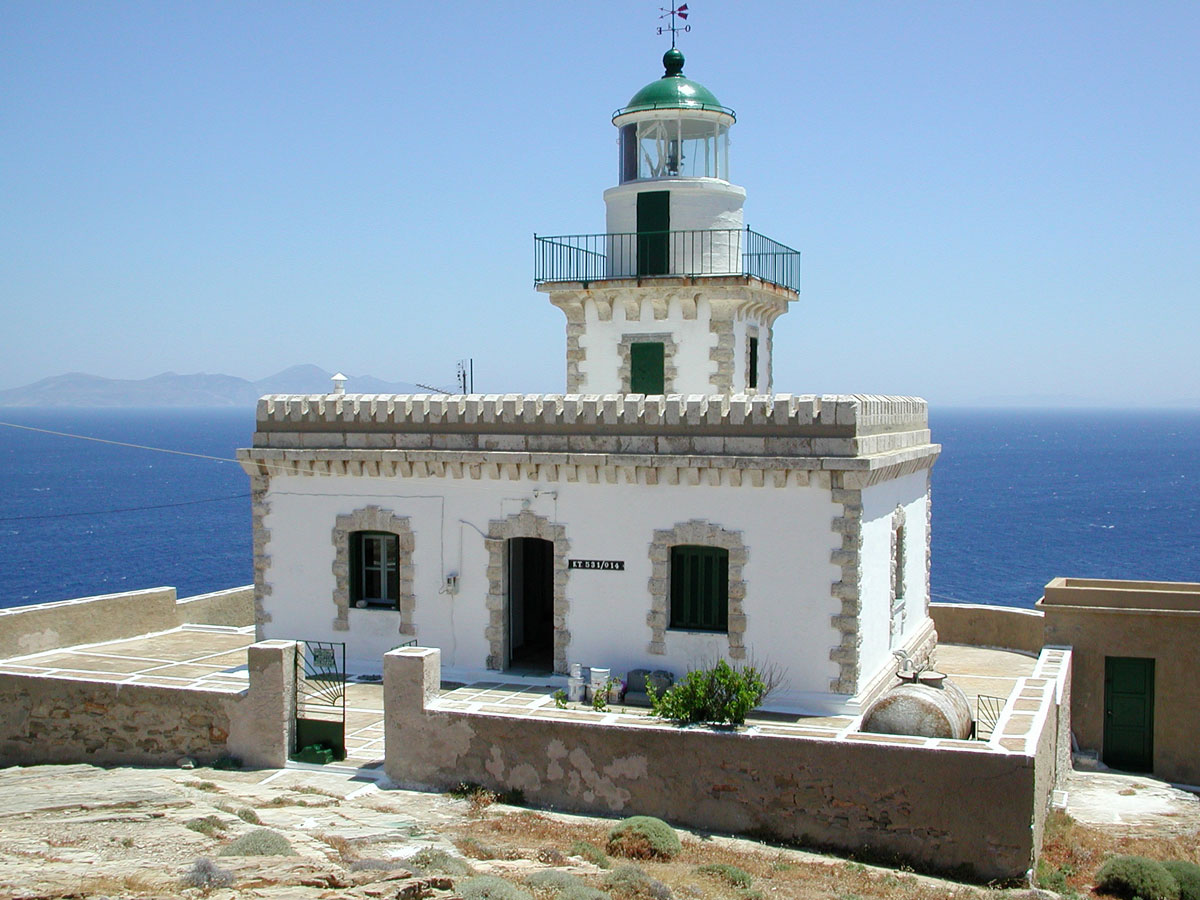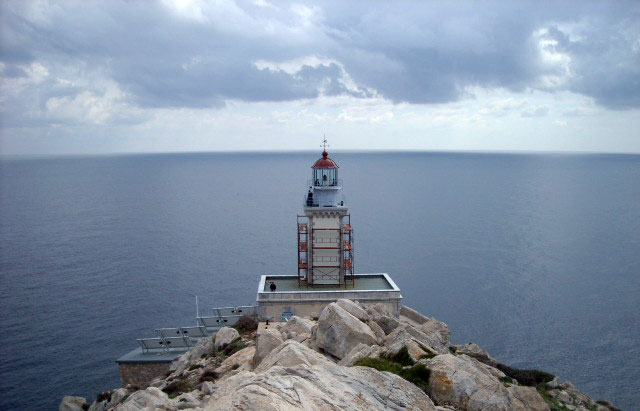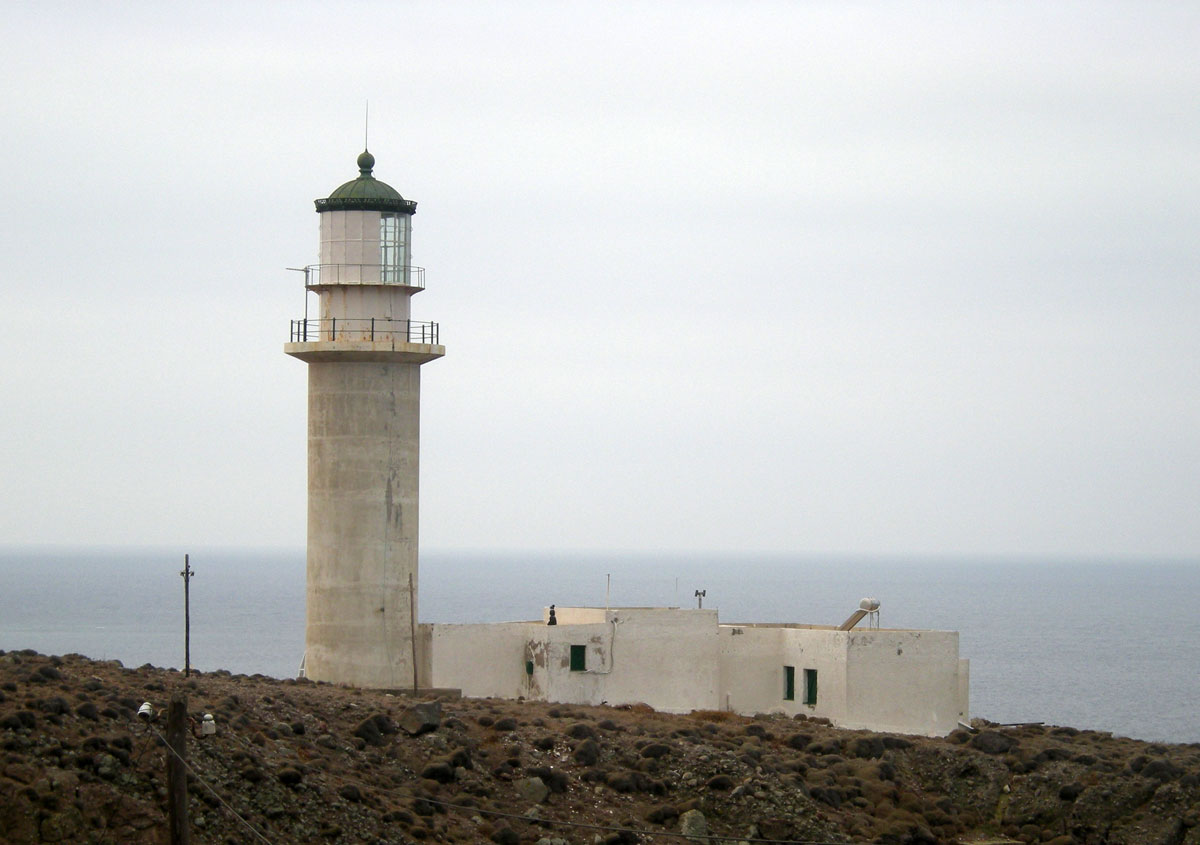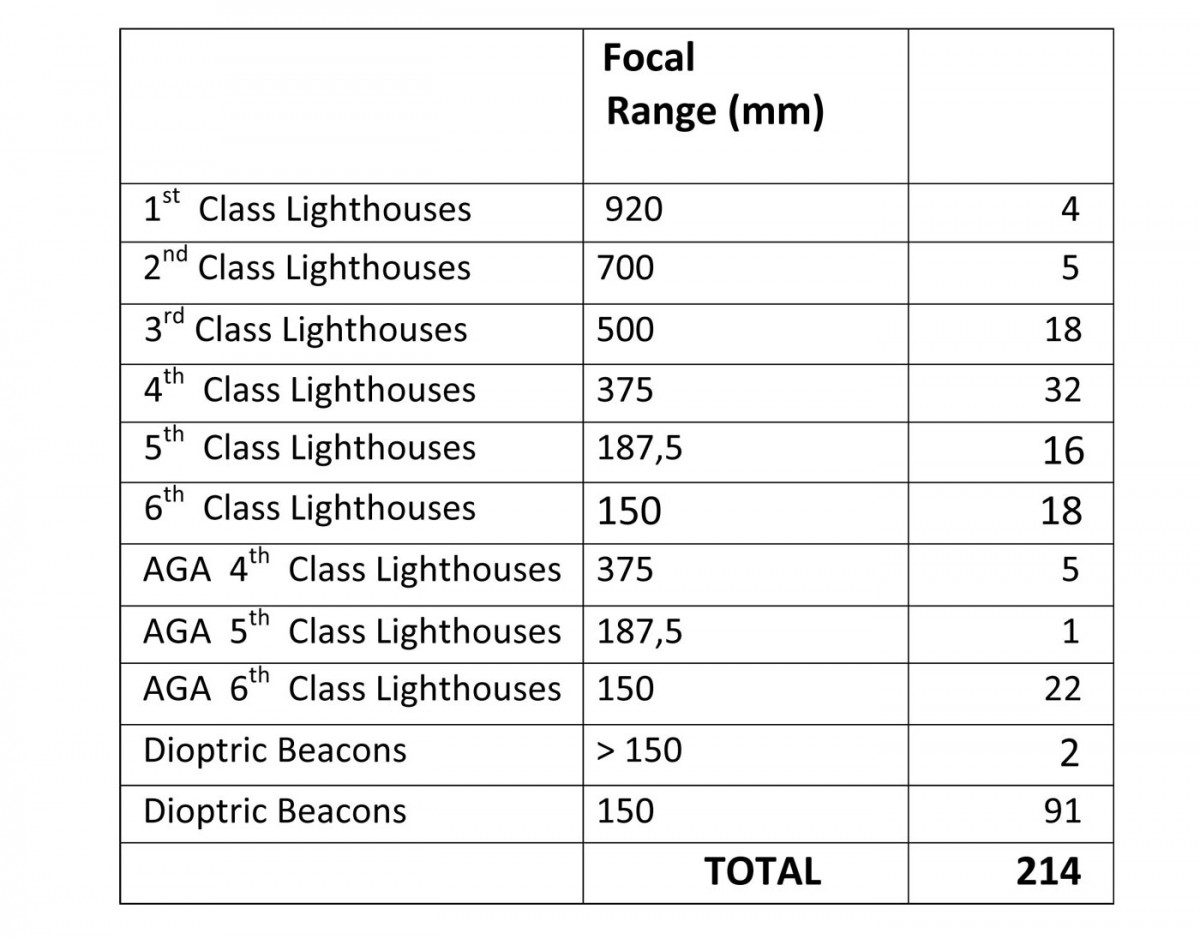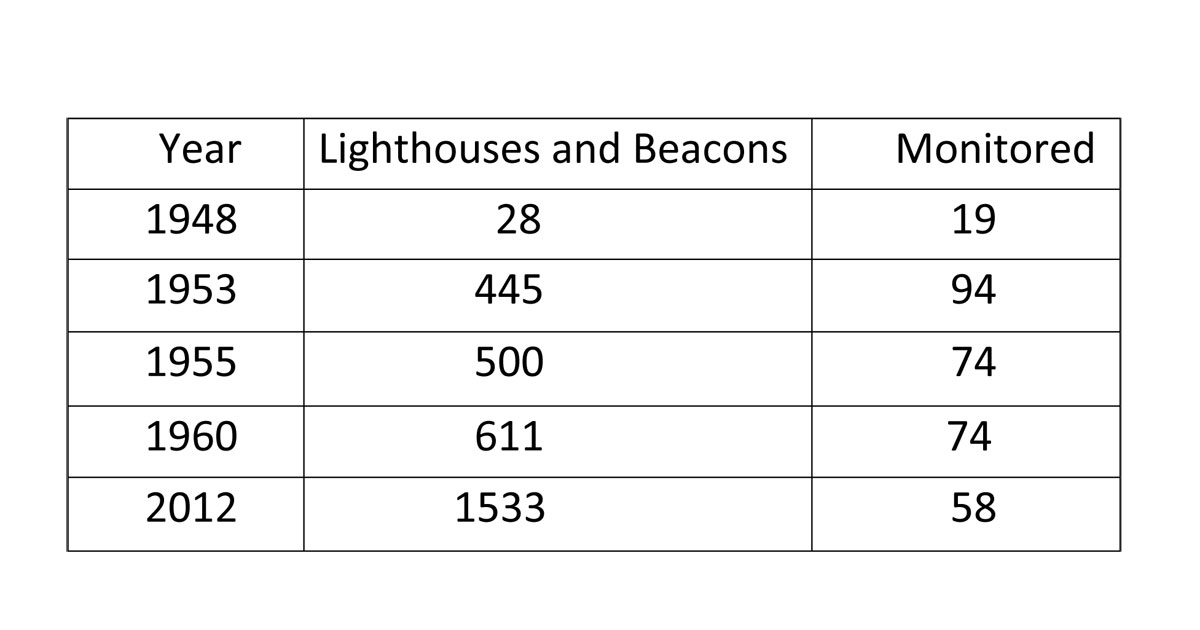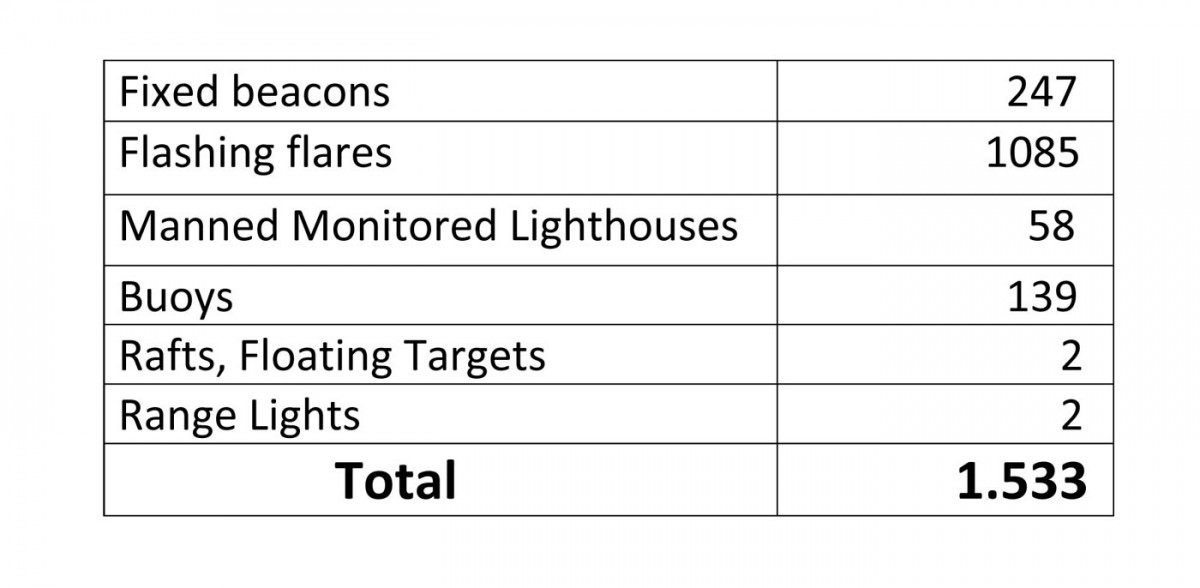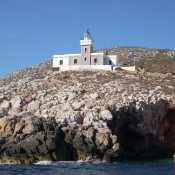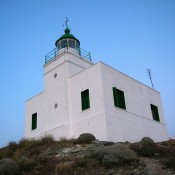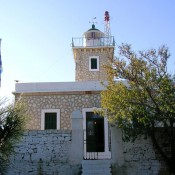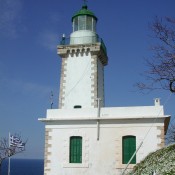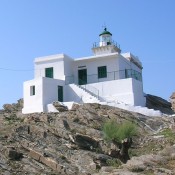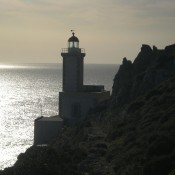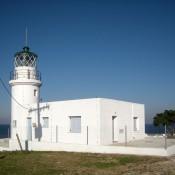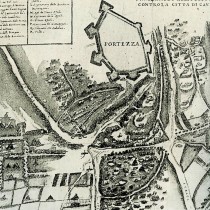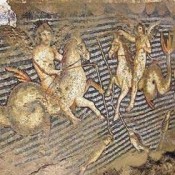The first known lighthouse in history started to be built in 296 B.C. and was completed in 280 B.C. on the Pharos islet at the NE end of the harbour of Alexandria. Its architect was the Greek Sostratos, son of Dexiphanis, from Knidos in Karia, during the time of Ptolemy Philadelphos.
«Ελλήνων σωτήρα φάρου σκοπόν, ω άνα Πρωτεύ / Σώστρατος έστησε Δεξιφάνους Κνίδιος. / Ου γαρ εν Αιγύπτω σκοπιωρείσθ’ απονήσων / αλλά χαμαί χηλή ναύλοχος εκτέταται. / Του χάριν ευθείαν τε και όρθιον αιθέρα τέμνων / πύργος όδ’ απλάτων φαίνεται από σπιλάδων / ήματι˙ παννύχιος δε θέων συν κύμματι ναύτης / όψεται εκ κορυφής πυρ μέγα καιόμενον / και κεν επ’ αυτού δράμοι, Ταύρου Κέρας ουδ’ αν αμάρτοι / Σωτήρος, Πρωτεύ ξείνιε, τήδε πλέων» (note 1).
The lighthouse was 157 m high and its luminosity was in the range of 30 nautical miles, lighting the coast and aiding navigation. It stopped operating in 1303 A.D. after a severe earthquake. Its partial collapse began in 1326 until in 1349 it collapsed completely.
Since very early times, the founding and operating of lighthouses has been related to the geographic location of each country and man’s necessity to travel beyond known boundaries and discover the far corners of the world. From the late 18th c, the demands of maritime trade and navigation required the development of an organized network of lighthouses which would protect all those sailing through narrow straits or regions with dangerous reefs and shoals and guide them to a harbour.
In the industrial revolution important engineers and inventors dealt with the evolution of lighthouse technology, lighting equipment, machinery and lenses. The following people are referred to indicatively:
– Argent, who in 1780 invented the incandescent lamp named after him.
– Lange, Meunier and Quinquiet, who in 1783 developed the Argent lamp.
– Sangrain, who in 1781 installed spherical mirrors on lighthouses.
– Lemoyne who in 1784 studied the variations of light on lighthouses.
– Teulere, Borda and Lenoir who in 1791 placed parabolic mirrors on lighthouses.
– Bordier and Marcet who in 1791 invented the reflecteur sideral.
– Lecoat de St Haouen who in 1811 studied the colouring of light and the features of lighthouses.
– Carcel who in 1800 invented the mechanical oil lamp and gave his name to the unit for measuring light intensity.
– Henry Lepaute who in 1825 invented a regulator for the speed of lighthouse machinery rotation.
– Augustine Fresnel who in 1819 invented the catadioptric lenses named after him. They were used in the lighthouse machinery bringing about a revolution by drastically increasing the range of light.
– Nils Gustav Dalen, engineer and founder of the AGA company who in 1905 invented a method for the automation of lighthouses by an acetylene helium valve, with which beacons lit automatically after sun set. Dalen was awarded with the Nobel prize for Natural Sciences in 1912.
Automatic AGA lighthouses gave great impetus to the development of the global network of beacons and after a relatively brief trial period allowed the most inaccessible spots on the Greek coastline to be lit.
King Otto was the first to attempt the organizing of the lighthouse network through the Royal Decree «Περί Οργανισμού Λιμενίων Αρχών» (“On the Port Authorities”) (ΦΕΚ 4/16-01-1834), in which port officers were declared responsible for the care of the beacons.
From the time the modern Greek State was established until 1887, the Ministry of the Interior and the Ministry of the Navy were both in charge of all lighthouses whose locations as well as those of the beacons were chosen without centralized planning.
In 1887, with law ΑΥΠΒ (no 1482) «Περί συστάσεως ταμείου των φάρων» (“On the establishing of a fund for lighthouses”) (ΦΕΚ 140/1887), Charilaos Trikoupis transferred the responsibilities for lighthouses to The Ministry of the Navy where the department for lighthouses was created. This took place after the recommendation of a committee set up by, then Minister of the Navy, Georgios Theotokis as chairman and the following members: Admiral Lejeune (from the French mission), Captain Aristides Reinek, Commander D. Miaoulis, Ioannis Markopoulos, former Officer of the Engineers, Head of Public Works at the Ministry of the interior and later the first Head of the Lighthouse Department over several years, Εduard Quellenec (from the French mission), Chief Engineer in charge of Public Works and P. Chrysanthopoulos, Head of the Merchant Marine Department.
Later that same year with the second decision of G. Theotokis, Minister for Maritime Affairs at the time, a committee is put together with the task of examining the study of I. Markopoulos and E. Quellenec «Έκθεσις περί του φωτισμού των ελληνικών παραλίων» (“Report on the lighting of the Greek coast”). Admirals Kanaris and Lejeune were appointed as Heads of the committee with the following members: Captain G. Stamatelos, Commanders K. Sachtouris and D. Miaoulis, Lieutenant Commander A. Miaoulis (the Navy’s first watercolourist), I. Markopoulos and E. Quellerec. Mansell, the English Admiral and great watercolourist, was also invited to participate, if his health should permit it.
Both these two committees, the first to specialize in lighthouses, as well as the decisions they took, are considered extremely important because they changed the history of lighthouses in Greece.
The study by I. Markopoulos and E. Quellerec was based both on the 11 international sea routes of that time and the 12 Greek coastal shipping routes. It provided the location, type, size, budget and order of construction work for the building of 73 new lighthouses and beacons and the modifying of 42 old ones for their total number to reach 141. These lighthouses and beacons constitute an important part of today’s Greek lighthouse network.
The work of lighting the Greek coast line was awarded in 1907 at the International Maritime Exhibition in Bordeaux with the Diplôme de Grand Prix(Great Honorary Prize). When most of the building of the Greek lighthouse network had been completed, the late Vice Admiral S. Lycoudis charmingly remarked that “the coast of Greece looks like a huge chandelier”!
In 1910 with law ΓΦΠ΄(no 3580) (ΦΕΚ 80/26-2-1910), the Lighthouse department were merged with the department of Hydrography in the Navy Ministry and for the first time a commander of the Royal Navy was made head of the department. At the same time, in 1914, according to law 276 (ΦΕΚ 156/30-12-1914), the responsibility for erecting and maintaining the buildings of the state’s lighthouses and beacons came under the newly established department of Maritime Public Works of the Navy Ministry with an officer of the Engineers as department head. Later on, this department was moved to the Ministry of Transport.
In 1915, with law 645 (ΦΕΚ 78/23-2-1915), the Lighthouse Directorate is founded in the Naval Ministry independent of all other services, totally responsible for the state lighthouses and beacons.
In 1951, law 1629 «On Lighthouses» is passed (ΦΕΚ 9Α/8-1-1951), which is still valid and governs the jurisdiction of state lighthouses, beacons and lamps and is applied by the Lighthouse Directorate of the Navy Ministry. With the abolition of the Navy Ministry, the Lighthouse Directorate was moved to the Ministry of Defence, came under the Navy General Staff and evolved into the present Lighthouse Service. It is governed till now by an Engineer, Commodore of the Navy and its staff is made up of higher and lower ranking military personnel of the Navy, lighthouse keepers and civilian personnel. Its headquarters, for those entering the port, are on the right hand pier of the outer harbour of Piraeus, somewhere between Pheidiou street and Klauthmonos square in central Athens as well as on the Vasileiadis Coast, in the reservoirs of the PPA where the warehouses and lighthouse workshops are based.
To seamen, through the ages, a lighthouse has meant a safe direction for his journey, a guide at night, a protector as well as a companion. The demand for establishing and operating lighthouses is directly linked to our country’s geographical location where the needs of navigation had long required the development of an organized network of lighthouses to protect those who sailed through dangerous narrow straits and allow them a safe passage to far away ports.
The importance of lighthouses becomes directly apparent if we keep in mind the large spread of our country’s coastline, the great number of islands, islets, rocky islets, straits, channels and harbours, as well as particularly great shipping activity due to Greece’s geographical position.
The mission of the Lighthouse Service is to establish, install, maintain and operate the necessary lighthouses, beacons and lamps for safe navigation in Greek waters. It is also responsible for informing seamen through announcements in the Hydrographic Service about the extinction, reactivating and new installations of beacons. Moreover, in cooperation, with the Hydrographic Service, the Lighthouse Service issues a list/index of lighthouses on the Greek coasts.
From all the above, it is easy to conclude that despite navigational means being up to date, lighthouses remain important nautical aids and furthermore, the Lighthouse Service has the extremely important and expensive mission of maintaining the functioning of the 1,533 beacons of the Greek lighthouse network.
A direct consequence of the Lighthouse Service’s mission, previously mentioned, is its important social work that could be summed up as follows:
It contributes decisively to the safety of shipping by protecting human lives and vessels, by guiding ships on a correct route and allowing them a safe approach to harbours. To each seaman a lighthouse symbolizes hope, optimism and smooth sailing.
It also contributes to the avoidance of any kind of accidental catastrophe or the pollution of the marine ecosystem which, as we know, have dire consequences on coastal regions, tourism, fishing and the economic activities of the districts in general.
It enhances the cultural value of stone lighthouses as historical, industrial and modern marine monuments by restoring them and including them in our cultural heritage
Lighthouse keepers and lighthouse ships, to the extent allowed by their mission and abilities, have rescued castaways, towed vessels that were adrift, informed and assisted the authorities in charge.
Finally, the lighthouse keeper’s presence in frontier regions was and still is extremely important. His daily raising of the Greek flag and his control of the area he is guarding, constitute a vitally important service to the nation.
Since antiquity, followed by the Byzantine era and even during Turkish rule, watch towers, towers and beacons on the islands and coasts of mainland Greece had a variety of purposes. They were mainly for defence, alerting the locals on the appearance of enemies and pirates, although it seems that they were of service to passing ships, by acting as beacons.
As revealed by different sources, it appears that lighthouses, in the Greek archipelagos, are lit since the 15th century: In the ports of Chios in 1420 (C. Buondelmonti), Rethymnon in 1651 (Marco Boschini), Piraeus (English Pilot 1671) and Mytilene in 1782 (J.B. Hilaire, Choiseul-Gouffier).
On the contrary, we encounter an organized lighthouse network in the Ionian Islands when they were under British rule at the start of the 19th century. In 1822, the first lighthouse lights up in the fortress of Corfu, followed in 1824 by a second one in Vardianous. In 1825 the first lightship is installed in Lefkimme, Corfu and the lighthouses of Lakkas and Madonna on the island of Paxoi light up. In 1828 the lighthouses light up at Aghioi Theodoroi in Argostoli and Kaparelli. In 1829 the light house lights up in Strophades, the mythical dwelling place of the Harpies. These are followed by lighthouses in Kryoneri on Zakynthos (1832), Aghios Andreas and the Lazaretto on Ithaki (1834), Moudari on Kythera (1857)and last, in the port of Zakynthos (1859). When the Ionian Islands became part of Greece in 1863, these lighthouses were added to the Greek lighthouse network.
In the newly formed Greek state, Governor Ioannis Kapodistrias, with help from the local authorities, started placing beacons in the entrances of ports. The first lighthouse to light up was in 1829,in the port of Aegina, on the Church of Aghios Nikolaos the Seaworthy.
In 1831 the following two beacons were installed: one in the old port of Spetses, paid for by the Goudis family, and one on the church of Aghios Nikolaos at the entrance to the natural harbour of Kea.
Until 1848, the Greek lighthouse network was made up of five beacons and a lighthouse, maintained by the municipal authorities. They were the following: The three beacons mentioned above and two in the entrance to the port of Piraeus; one next to the tomb of Themistocles, in what is today the Aegean Maritime Administration (NTA) and one in the location known as Pyrovoleio (Gun–emplacement), on the pier of the later pre war factory for the production of fertilizers owned by Bodosakis. Last in the then network was the first lighthouse of the new Greek State, on Gaidouronisi, in the entrance to the harbour of Syros. It was built before 1848, without the exact date having been verified, with the designs and supervision of the Bavarian architect Johann B. Erlacher and funded by the Greek state. Its circular tower, the highest in Greece, is 29,3m tall with 125 steps.
At the beginning of the 2oth century, Stylianos Lykoudis, Vice admiral of the Royal Navy, member of the Academy of Athens and Head of the Lighthouse Service over several years, became associated with the development of the lighthouse network in Greece. He was born in Ermoupolis in 1878, the son of lawyer and writer Emmanuel Lykoudis and Demetra Blatse. In 1891 he entered the Naval Academy from where he graduated in 1895 with the rank of Ensign. It should be noted that at the time he was the youngest officer in the Royal Navy. In 1910 he became captain of the destroyer «Λόγχη» (Spear), moved up to commander in 1914, then to master in 1920, finally to retire in 1941 with the rank of Vice admiral. He was head of the Light house Service from 1913 to 1941, as well as professor at the Naval Academy. He served in the Royal Navy for 53 years, 8 months and 5 days which makes him the longest serving officer in the RN. In 1928 he was voted associate member of the Athens Academy and in 1939 unanimously a full member. It should be noted that after his death, his seat at the Athens Academy was filled several years later by Vice Admiral Demetrios Phokas, also head of the Lighthouse Service. Lykoudis wrote several papers on lighthouses, the most important of which is the «Ιστορικόν περί των φάρων των ελληνικών ακτών» (the History of Lighthouses on the Greek coasts) (note 2). He was also interested in linguistics and nautical terminology. At the same time he collaborated with Greek encyclopedias, dictionaries and newspapers. The Navy honoured him by giving the name «Lykoudis» to one of the ships that is active today in lighthouse connected missions (CNG). He was married to Angeliki Loungi and had a daughter named Bella. He died in Athens in 1958.
35 lighthouses and beacons were added to the Greek lighthouse network in 1915, after the Balkan wars, the liberation of the new countries and Crete’s union with Greece. These lighthouses had been constructed and were maintained by the French general partnership “Administration Générale des Phares de l’Empire Ottoman”, following an agreement with the ottoman government. After almost two years of negotiations, the Greek government paid compensation to the French company for the affiliation of these lighthouses.
In 1920, just before the Catastrophe of Asia Minor, the Greek lighthouse network was flourishing, as by now it was well organized and numbered 214 lighthouses and beacons (table 1).
The German occupation left its mark on Greece. After the country’s liberation, the lighthouse network was found to have been completely destroyed by the Germans and at the end of 1944, only 28 lighthouses and beacons were functioning, 19 of which were monitored by lighthouse keepers.
Since 1945, although efforts had initially been made to restore the lighthouse network, real results started to show only after the end of the civil war. Subsequent progress was tremendous (tables 2, 3).
Traditional stone lighthouses and beacons constitute a special chapter in the history of the Greek lighthouse network. Today, thanks to the efforts of many years and many people, there are 141 registered traditional stone lighthouses and beacons, 58 out of which are manned or monitored by lighthouse keepers, while this is not possible for the remaining 83, as they are in very poor condition.
These stone lighthouses and beacons were built around the turn of the century. Most of them were destroyed and then repaired after the Second World War. Moreover, they are traditional industrial monuments with a particular architectural structure, still contributing to shipping’s development and security, linked to Greece’s maritime tradition and a point of reference for seamen. They are protected by law 3028/02 «Για την προστασία των Αρχαιοτήτων και εν γένει της Πολιτιστικής Κληρονομιάς» (“On the protection of Antiquities and of Cultural Heritage in general”), as well as by law 2039/92 «περί Κύρωσης της Σύμβασης για την Προστασία της Αρχιτεκτονικής Κληρονομιάς της Ευρώπης» (On Ratification of the Contract for the Protection of Europe’s Architectural Heritage). To this day, 36 of them, that is almost ¼ of their total number, have been declared listed Modern Historical Monuments by the Ministry of Culture and Tourism. Meanwhile the Lighthouse Service constantly requests that as many lighthouses and beacons as possible be declared Historical Monuments by the same Ministry.
The maintenance of the 58 lighthouses and beacons either manned or monitored by keepers is carried out by the Lighthouse Service, depending on funds available at the time.
Due to weaknesses inherent in the funding for restoring and maintaining the lighthouse buildings of the extended network , the Lighthouse Service proposed in 2007 that it be included in NSRF 2007-2013 through the programme «Ανάδειξη Πολιτισμικής Αξίας Πέτρινων Φάρων» (Enhancement of the Cultural Value of Stone Lighthouses) and that 46 lighthouses be restored.
At this stage, following long term efforts through the support of NSRF 2007-2013,the Kokkinopoulos Lighthouse in Psara has been funded with a total budget of 497.000€, as well as the lighthouse of Monemvasia with 667,000€,while it seems that only three more works of restoration still have hope of funding; the lighthouses of Trikeri in Magnesia, Konchi in Salamina and Aghios Elias in Amorgos.
The following 17 lighthouses were restored in the six years between 2007 and 2013, after constant efforts from the Lighthouse Service: 10 lighthouses with funding from the Lighthouse Service’s own resources (Spathi on Seriphos, Korakas on Paros, Kapsali on Kythera, Gourouni on Skopelos, Sigri on Mytilene, Kassandra in Chalkidiki, Aghios Nikolaos on Kea, Drepano in Chania, Sousaki in Korinthia and Vrysaki in Lavrion. Four lighthouses with public funding through the local authorities of Municipalities and Prefectures (Aghios Sostis in Mesolonghi, M. Emvolo in Angelochori, the lighthouse of Ios and the Castle of Mytilene). Three lighthouses with private funding from the Non Profit Making “Aikaterini Laskaridis Foundation” (Dana on Poros, Tainaron and Maleas in Lakonia).
The restoration of these three historical and legendary lighthouses carried out between 2008 and 2011 by the Aikaterini Laskaridis Foundation with the architect Dimitris Eutaxiopoulos, was of decisive importance for the future of Greek stone lighthouses which, till then, had seemed ominous.
The love for Greek lighthouses shown by the Foundation’s president Mr Panos Laskarides and his important contribution to their conservation marked a new beginning in regards to their restoration and enhancement.
Since 1981 the Lighthouse Service is part of the international non profit making organization IALA (International Association Lighthouse Authorities). This was founded in 1957 and established a uniform system of shipping signals, based on modern lighthouse material and international experience.
In May 2001, on Spetses, the Lighthouse Service successfully organized IALA’s 10th Session on the “Preservation of Historical Stone Lighthouses” with the participation of conference members from many countries. The Lighthouse Service received letters of congratulation for the successful outcome from, among others, the Trinity House Lighthouse Service (the English Lighthouse Authority) and the CETMEF (The French Lighthouse Authority).
Twelve years later, in June 2013, the Lighthouse Service successfully organized in Piraeus an international conference on the restoration of Historical Stone Lighthouses. It hoped to raise awareness in as many responsible agencies as possible ,in Greece and world wide, on the need to save these monuments. There were 65 participants from 15 countries in this event on the issue of “Preserving the Heritage of Lighthouses”.
Furthermore, the Lighthouse Service collaborates with Institutions such as the Aristotle University of Thessaloniki, the National Technical University of Athens, Patras University, the University of Crete and the Ionian University to provide information on new technologies and to enhance know-how on methods for the restoration of stone Lighthouses so as to help prepare surveys and proposals on restoring many of them. Mention should be made particularly of Professor Ioanna Papagianni of the Aristotelian University of Thessaloniki and of Associate Professor Nikos Belavilas of the National Technical University of Athens (ΕΜΠ) for their huge scientific but personal contribution as well to the rescue of Lighthouses in Greece, the spreading of the ideas of these monuments conservation and their undivided help in the Lighthouse Service.
In place of an epilogue and as a special honour, I should like to quote with the pen of S. Lykoudis a small reference to the hermits of the lighthouses ,the lighthouse keepers ,a special corps in the Royal Navy since the early years of the Greek lighthouses’ operation: «Ήδη επιτραπήτωσαν ημίν ολίγαι λέξεις διά τους ταπεινούς όσον και ταλαιπωρουμένους μαρτυρικώς πολλάκις υπαλλήλους, τους αποτελούντας το προσωπικόν, το οποίον χειρίζεται την ψυχήν των μηχανημάτων, το τόσον ευεργετικόν διά τους πλωιζομένους φως του φάρου. Οι ημέτεροι φαροφύλακες […] είναι ουχ ήττον και ούτοι από πολλών απόψεων μάρτυρες, βρίθει δε και αυτών ο βίος επεισοδίων ικανών όπως παράσχωσιν αμυδράν εικόνα του ταλαιπώρου επαγγέλματος των βιοπαλαιστών τούτων […]. Πολλοί τούτων υπήρξαν ναυτικοί τραγικής τύχης, απολέσαντες τα πάντα εις την θάλασσαν, πλοίον, περιουσίαν, οικείους…» (in free translation: May we now be allowed to say a few words about the humble as well as frequently suffering employees, who make up the personnel which operates that soul of the machinery, the light of the beacon which is so beneficent for those at sea. Our lighthouse keepers … are, from many points of view, in no less a position than a martyr, their lives are also full of such incidents that give a faint picture of these breadwinners’ miserable work … Many of them were seamen who through some tragic fate lost everything at sea; their ship, their fortune, their families… (note 3).
Panagiotis Chiotis
Mechanical Engineer
Head of Marine Public Works for Lighthouses of the Hellenic Navy’s Lighthouse Service.
* The article is a revised text from the publication K. Παγουλάτου-Κυπαρίσση (ed.), Πετρόκτιστοι φάροι. Ταίναρο και Μαλέας, Aikaterini Laskaridis Foundation, 2013.
